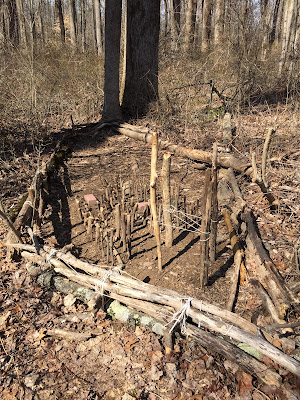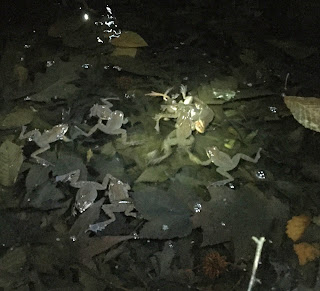The boulders along the ridge are rounded, composed of diabase, which in my experience is associated with rare plant species that thrive in the particular kind of soil generated from the weathering of these rocks. The boulders were not deposited here by glaciers, but instead formed from molten upwellings from below. In Herrontown Woods and Autumn Hill Reservation there are numerous little abandoned quarries where some of the larger boulders were split into chunks and hauled away.
News from the preserves, parks and backyards of Princeton, NJ. The website aims to acquaint Princetonians with our shared natural heritage and the benefits of restoring native diversity and beauty to the many preserved lands in and around Princeton.
Sunday, March 27, 2022
Some Spring Sightings at Herrontown Woods
The boulders along the ridge are rounded, composed of diabase, which in my experience is associated with rare plant species that thrive in the particular kind of soil generated from the weathering of these rocks. The boulders were not deposited here by glaciers, but instead formed from molten upwellings from below. In Herrontown Woods and Autumn Hill Reservation there are numerous little abandoned quarries where some of the larger boulders were split into chunks and hauled away.
Saturday, March 12, 2022
A Night-time Visit to a Vernal Pool Along the Princeton Ridge
Here are a couple wood frogs in what's called "amplexus," with the smaller male holding onto the pinkish female. It looks all very ordered and peaceful, but when we visited a vernal pool in Herrontown Woods a week ago, the competition between males for females was intense, to the point of imperiling the females.In this photo, by Mark Manning, the tussle looks pretty benign.
Lincoln Hollister Leads a Geology Walk (POSTPONED)
The walk is at 1pm. A limited number of spots are available. Click here to sign up.
Also at Herrontown Woods this Sunday, and just about every Sunday of the year, volunteers gather from around 10:30 to 1pm to work in the Barden and elsewhere in Herrontown Woods, weeding, cutting down invasive species, and improving trails.
On first Sunday's of the month, from 10am-noon, FOHW hosts May's Barden Cafe, serving coffee, tea, and pastries in the tradition of Elizabeth "May" and Oswald Veblen, who donated Herrontown Woods back in 1957.





















